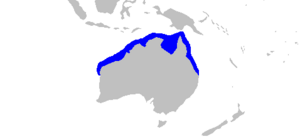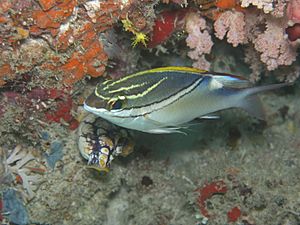Creek whaler facts for kids
Quick facts for kids Creek whaler |
|
|---|---|
 |
|
| Conservation status | |
| Scientific classification | |
| Genus: |
Carcharhinus
|
| Species: |
fitzroyensis
|
 |
|
| Range of the creek whaler | |
| Synonyms | |
|
Galeolamna fitzroyensis Whitley, 1943 |
|
The creek whaler (Carcharhinus fitzroyensis) is a common type of requiem shark. It belongs to the Carcharhinidae shark family. This shark is found only in northern Australia. It likes to live in shallow waters close to the shore, including river mouths.
This small, strong shark usually grows to about 1.0 to 1.3 meters (3.3 to 4.3 feet) long. It has a brownish color and its fins do not have any special markings. You can tell it apart by its long snout and large, triangular pectoral fins. It also has a big first dorsal fin that is placed quite far forward on its back.
Creek whalers mainly eat small bony fish and crabs and shrimp. They are viviparous, which means their babies grow inside the mother. The young sharks get food from their mother through a special connection called a placenta. Mating happens from May to July. Female creek whalers give birth to one to seven pups each year. Their pregnancy lasts about seven to nine months.
Some creek whalers are caught by accident in fishing gillnets near the shore. They are then used for food. However, fishing does not seem to harm their overall population much. Because of this, the IUCN says this species is of Least Concern. This means they are not currently at risk of disappearing.
Contents
About the Creek Whaler Shark
The creek whaler shark was first described by an Australian fish scientist named Gilbert Percy Whitley. He wrote about it in 1943. He named it fitzroyensis because the first shark studied was found in the Fitzroy River estuary. Scientists later decided that this shark belongs to the Carcharhinus genus.
Scientists are still studying how the creek whaler shark is related to other sharks. Some studies suggest it might be related to sharks like the whitecheek shark or the blackspot shark. Other studies using DNA show it might be an early relative of sharks like the graceful shark and the blacktip shark.
What Does a Creek Whaler Look Like?
The creek whaler has a body shape that is like a spindle and is quite strong. Its long snout is shaped like a narrow curve. It has large nostrils with small, nipple-like skin flaps in front of them. The shark's eyes are round and medium-sized. They have special eyelids called nictitating membranes. The mouth is curved with very short grooves at the corners.
This shark has 30 rows of teeth in its upper jaw and 28 to 30 rows in its lower jaw. The upper teeth are long and triangular with strong saw-like edges. The lower teeth are thin and stand straight up with fine saw-like edges. It has five pairs of short gill slits.
The pectoral fins of the creek whaler are very large and triangular. They have rounded or pointed tips. The first large dorsal fin starts above the back part of the pectoral fins. The second dorsal fin is quite tall and long. It starts over or slightly behind the anal fin. There is no ridge of skin between the two dorsal fins. The anal fin is larger than the second dorsal fin.
Near the tail, there is a curved notch on the caudal peduncle. This is just before the top part of the caudal fin (tail fin) begins. The tail fin is not symmetrical. It has a well-developed lower part and a longer upper part with a notch near its tip. The shark's skin is covered in tiny, overlapping scales called dermal denticles. Each scale has three to five ridges.
The creek whaler is usually bronze to brownish-gray on top and pale underneath. It does not have a clear lighter band on its sides. Sometimes, a shark might be light bluish-gray on top. While some can grow up to 1.5 meters (4.9 feet) long, they are usually between 1.0 and 1.3 meters (3.3 to 4.3 feet) long.
Where Creek Whalers Live
The creek whaler shark lives only in northern Australia. You can find them from Gladstone in central Queensland to Cape Cuvier in Western Australia. They are a common shark species. They live in river mouths and coastal waters. They can be found from the area where the tide goes in and out, down to a depth of at least 40 meters (130 feet).
Creek Whaler Diet and Life Cycle
The creek whaler mostly eats small bony fish. These include threadfin breams and lizardfishes. They also eat crabs and shrimp, such as penaeid prawns and mantis shrimps. Sometimes, they might eat cephalopods like squid or octopus. This shark can have parasites, including a type of tapeworm and a nematode worm.
Like other sharks in its family, the creek whaler is viviparous. This means the baby sharks grow inside the mother's body. They get food from the mother through a special connection called a placenta. Female creek whalers have one to seven babies each year.
Mating happens between May and July. The females can store the sperm until they are ready to release their eggs, which happens between July and September. After being pregnant for seven to nine months, the babies are born between February and May of the next year.
Newborn creek whalers are about 35 to 50 centimeters (14 to 20 inches) long. They spend their first few months in shallow coastal areas that act as nurseries. One such nursery area is Cleveland Bay in north Queensland. Male sharks become ready to have babies when they are about 83 to 88 centimeters (33 to 35 inches) long. Females are ready when they are about 90 to 100 centimeters (35 to 39 inches) long.
Creek Whalers and People
The creek whaler is sometimes caught by accident in gillnet fishing in northern Australia. Their meat is sold for people to eat. However, because these sharks can have many babies, their population seems to be able to handle the current level of fishing. This is why the IUCN has listed this species as being of Least Concern.
See also
 In Spanish: Tiburón ballenero para niños
In Spanish: Tiburón ballenero para niños



